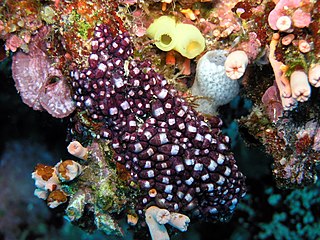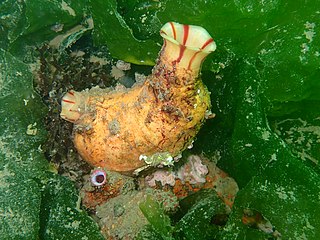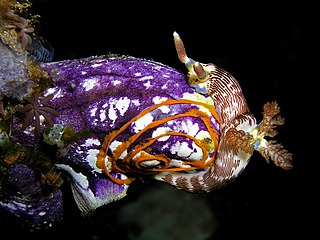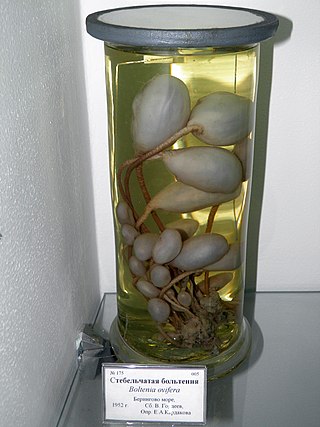
Microcosmus is a genus of tunicates in the family Pyuridae, containing the following species:

Eusynstyela is a genus of ascidian tunicates in the family Styelidae.

Halocynthia is a genus of ascidian tunicates in the family Pyuridae. Species such as H. roretzi are eaten in parts of Asia as a delicacy.

Pyuridae is a family of tunicates.

Stolidobranchia is an order of tunicates in the class Ascidiacea. The group includes both colonial and solitary animals. They are distinguished from other tunicates by the presence of folded pharyngeal baskets. This provides the etymology of their name: in ancient Greek, στολίς, ίδος means the "fold" of a cloth. Stolidobranchian sea squirts are also characterized by the complete absence of an abdomen. The abdominal organs of other tunicates are instead located to one side of the pharyngeal basket in this group.

Styelidae is a family of ascidian tunicates.
Alloeocarpa is a genus of ascidian tunicates in the family Styelidae.
Bathyoncus is a genus of ascidian tunicates in the family Styelidae.
Bathystyeloides is a genus of ascidian tunicates in the family Styelidae.
Chorizocarpa is a genus of ascidian tunicates in the family Styelidae.

Distomus is a genus of ascidian tunicates in the family Styelidae.
Gynandrocarpa is a genus of ascidian tunicates in the family Styelidae.

Metandrocarpa is a genus of ascidian tunicates in the family Styelidae.
Monandrocarpa is a genus of ascidian tunicates in the family Styelidae.
Oligocarpa is a genus of ascidian tunicates in the family Styelidae.

Polyzoa is a genus of ascidian tunicates in the family Styelidae.
Stolonica is a genus of ascidian tunicates in the family Styelidae.

Symplegma is a genus of ascidian tunicates in the family Styelidae.
Theodorella is a genus of ascidian tunicates in the family Styelidae.

Boltenia is a genus of ascidian tunicates in the family Pyuridae.










